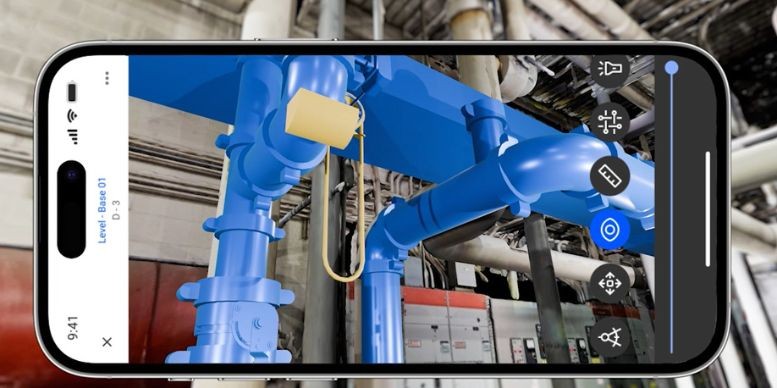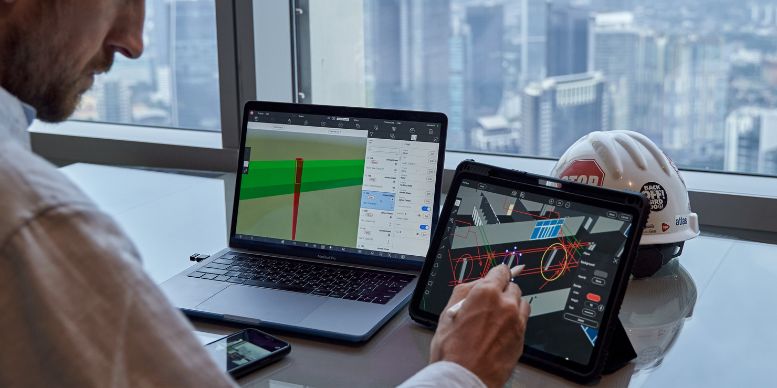
Blog / BIM & Construction Management
BIM Integration into Business Processes
Categories

Digital transformation of the Engineering, Construction and Operations (E, C & O) industry is all but guaranteed, with extensive research and reporting proving so. The long-standing issues of high complexity and low productivity that have been plaguing the industry can actually be greatly diminished if not resolved. That can only happen if the industry tackles the opportunity of global digitalization. Such opportunities are extremely rare and are capable of having profound effects on the industry as a whole.
Full-scale digitalization can have extensive benefits, including massive cost savings. However, the process of achieving that specific scale of digitalization is still a mystery to many companies. This is where Building Information Modelling (BIM) takes the stage.
The original concept of BIM was to collaboratively design assets within one comprehensive data system that consists of digital models and not drawings. However, some of the more recent definitions of BIM refer to it as a collection of processes, tools, and a specific mindset. This combination represents the need for digital innovation for the entire construction industry.
The definition of BIM that we're going to use in this text is this – BIM is a digital representation of a facility's various characteristics (functional or physical) in its entire life cycle. This text's main goal is to explain how E, C & O companies can put BIM at the heart of their construction businesses to improve project delivery, among other benefits.
At the same time, the main purpose of the design phase has changed dramatically as well. Instead of just providing a projection of the end result that is needed, design is now more about sharing information and various details that should increase the efficiency of the project's execution in a building's lifecycle.
The process of project realization
The construction process on its own is not exactly an easy task, to begin with. The number of participants in a single project depends on how complex the project is and other things. As the number of participants grows, so does the complexity of controlling and managing the entire process.
It is possible to discern three main stages of any construction process – Design phase, which handles the concept creation, as well as the 3D model filled with information; Building phase, which includes all of the construction efforts that are actually performed and analyzed; and Management phase, which encompasses the entire span of the building's lifecycle up to the point of deconstruction. The accumulation of data from a single step brings benefits throughout different stages of said process, and this is why it's critical to keep the entire lifecycle in mind.
To make the entire project's combination of processes easier to understand, it's also possible to discern seven main process groups that take place in one or the other phase of the construction process. As such, we're presenting a list of these process groups:
Design Phase
- Quantity take-off, design and validation processes
- Cost estimations and pricing
Building Phase
- Budgeting and scheduling
- Prefabrication/procurement
- Tracking of the construction and reporting
Management Phase
- Asset management/facility management
It is worth noting that some of the processes overlap into two or more project phases. Project management (+ Finances) efforts encompass all three project phases, and processes like cost estimations, tracking & reporting benefit two phases at once – Design and Building, and Building and Management, respectively.
An explanation of the project phases is also needed. The Design phase covers the creation and enrichment of the 3D geometry with various parameters and metadata. The number of errors and changes can be reduced by having proper coordination between different design disciplines. After the 3D model is created and enriched, it gets validated and is used for predicting the exact price and the amount of materials and time that is needed to complete the project's Building phase.
Speaking of the Building phase, it's also something that requires detailed planning to ensure the proper flow of the different processes that are included in the Building phase. In this, a schedule is created that consists of several different activities, each getting its share of resources and allotted completion time. The combination of these resource expenses and the potential amount of time needed allows for the creation of the budget estimates, which can be later used for several different purposes, such as cash flow management.
At the same time, materials are produced by approved vendors and a mass of field data is constantly collected and used to monitor the construction process. Quality checks are performed regularly and results are also linked to the BIM model, as well as any changes that differ from the intended design.
The Management phase, on the other hand, covers the process of building's regular usage. At this stage, the optimal usage of the assets and facilities, as well as the maximized ROI, are ensured via the proper appliance of the facility management.
Various challenges of a construction project

After explaining the gist of the construction process, it's important to go over the different challenges that appear at each phase of the project. Industry-related challenges are not taken into consideration here (sustainability, low productivity, etc.) since those are regularly covered, so we will focus on the typical problems of industrialization and digitalization for the majority of E, C & O companies.
Design Phase
As simple as it might sound, one of the biggest challenges of the design phase as a whole is ensuring you're doing what is needed. This includes optimizations within the current situation and the necessity to deliver a design that presents the owner with the greatest value.
It's not uncommon for minor design changes to affect a massive amount of the project's parameters, including its costs and operations. This is the main reason why it is essential to have accurate information for your costing, scheduling, and quantification efforts.
Building phase
After the design's approval, another rather simplistic challenge arises, which is proceeding with doing everything the right way. High levels of transparency in procurement, construction, and production are necessary for proper project monitoring and tracking material flow. As with the design phase, the smallest delays are capable of throwing a wrench into your plans, disrupting procurement processes, spawning schedule problems, and so on.
Management phase
Management relies heavily on the information collected in the previous phases since that kind of information is essential to perform management tasks correctly. The problem here is managing all the information that you have to prevent and resolve issues as soon as possible. While it is possible to automate some tasks with the help of IoT sensors and other appliances, the problem of too much data being easily accessed is still there.
Old vs. New
The "Old way" to approach the problem of having relevant and accessible data is to have a scattered landscape of multiple solutions with little to no integration or cooperation between them. While single-point solutions are good at what they do, applying the same solution to all of your problems leads you to more problems, from project tracking issues to the lack of transparency as a whole.
Additionally, if tasks are split between different systems, business processes get increasingly complex, which disrupts user adoption processes and makes it exponentially harder to further scale your business. The lack of integration and a heterogeneous software landscape makes the high level of automation impossible to achieve, thus putting a damper on the attempt to industrialize the construction process.
This is why a completely new approach to BIM processes is needed.
Using BIM as a common denominator and the centre of a company's project-related processes makes it easier to have a transparent process in general, making it possible to provide a single source of truth by linking all project information together and providing a simple user interface to work from. Integrating all three construction phases into BIM is necessary to allow for design risk elimination, proper material procurement, and strategy implementation. The same goes for all of the process groups that are included in these phases.
Another important topic is internal cooperation, which becomes much easier with the integration of BIM. Efficient communication is capable of doing wonders for any project. Speaking of communication, better communication with stakeholders and other external parties is also achievable via BIM integration. That way, it's possible to reduce the number of conflicts and modifications in the middle of the building phase. The importance of external collaboration is steadily increasing with the implementation of more complex project management frameworks, such as Public-Private Partnership or Integrated Project Delivery.
The technology and its benefits
Many of the E, C & O-related challenges can be solved by implementing BIM as the literal heart of your business processes. The integration of the BIM and ERP technologies has been made possible thanks to the evolution of both of them. Since this kind of integration is possible without any kind of middleware, the processes themselves can be made simple and be hosted in a unified IT landscape.
A comprehensive software platform is needed to properly run your business processes that are project-centric. One example of such a platform is SAP S/4HANA, a modern ERP system that can work with business processes in many branches, from sales and procurement to project management.
Another BIM platform with the capability to visualize the geometrical 3D model is required as well since ERP systems cannot typically support BIM workflows as a whole. One such example is Autodesk Forge, capable of visualizing the model from the cloud, as well as storing and accessing it whenever necessary.
There are many benefits that come from this kind of approach, including increased efficiency and reduced operational costs. At the same time, the whole idea of integrating ERP with BIM is a relatively new one and not as commonly used as BIM in general. However, such integration could increase several different aspects of the projects, such as process monitoring improvements, better planning detailing, material flow tracking, and more.
While BIM can provide information about the quantities and the parameters of the materials, ERP can figure out its costs and create plans based on that information, including the time needed to assemble/construct all of its elements. Additionally, ERP manages production and delivery processes, as well as inventory tasks, financial reporting, project invoicing, and several other related matters.
That being said, developing custom solutions from the ground up is not necessary to achieve this level of integration between BIM and ERP, since there are already solutions that are capable of doing so, reducing risks and improving the success rate of your investments.
Revizto and its purpose
Revizto is a company that was founded back in 2008 and is headquartered in Lausanne, Switzerland. Its main field of work is real-time issue tracking software for the AEC industry. It aims to provide a unified BIM collaboration platform for both 2D and 3D workflows to allow users to communicate with each other in a collaborative environment.
The mission of Revizto is to bring powerful 3D technology and cloud solutions as the means of solving various problems in many different fields, such as architecture, engineering, construction, and facility management. Minimizing the gap between build and design phases, allowing for easier collaboration, and speeding up the project cycle – these are just some of the missions that Revizto aims to achieve.
Related module


